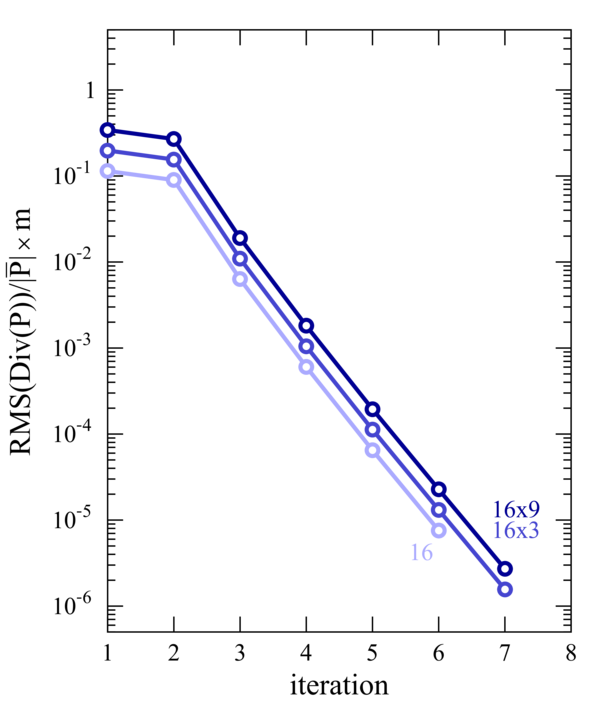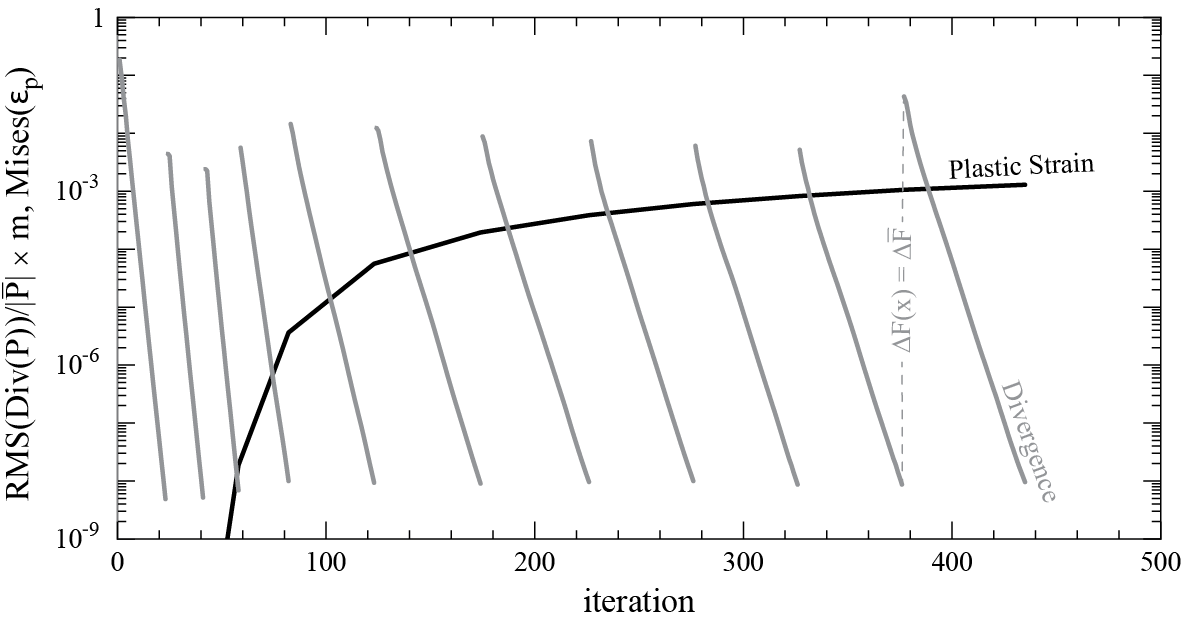1.3. Spectral Solver
Introduction
The present implementation is based on the works by P. Suquet [3] and R.A. Lebensohn [4].
The »basic scheme« included in DAMASK is described in [1] and [2].
As an faster and more robust variant of the originally proposed fix-point algorithm, DAMASK includes also a variant using any suitable non-linear solver provided by PETSc.
As an second alternative, an version using the Polarization field is included.

Solver variants
Basic
Polarization

Convergence criterion
Since the iterative »basic scheme« (using either the fix-point algorithm or a non-linear solver provided by PETSc) strictly maintains compatibility, it is only necessary to achieve (static) equilibrium.
As suitable convergence criterion Moulinec and Suquet [3] suggested
\begin{alignat}{1}
\varepsilon_\text{eq} \ge \frac{\operatorname{RMS}(\operatorname{Div} \textbf{P}(\textbf x)) }{|| \bar{\textbf{P}}||} \times \text{m}
\label{eq:convergenceCriterion}
\end{alignat}
based on the the root mean square (RMS) value of $\operatorname{Div}(\tnsr P)$, which can be conveniently calculated in Fourier space employing Parseval's theorem.
Corrections for physical size and grid resolution
The magnitude of the divergence depends on the distance between two neighboring Fourier points, i.e. for the same number of Fourier points but different physical dimension the iterative scheme will stop after different numbers of iterations.
To correct for a dependence on the size and resolution of the volume element (VE), the spectral solver can be instructed to rescale all grid point distances by the same factor such that
for the dimension with the medium pixel resolution a grid point distance of
- as before (uncorrected)
- 1 meter / grid point number (fixed dimension)
- 1 meter (fixed grid point distance, default)
- 1 meter / square root of grid point number (dimension and square root resolution corrected)
is obtained.
Fixed grain structure at varying VE size and resolution
As example we take a cubic grain structure (included as example in DAMASK) at either 1 or 10 m side length and discretized by either 16
3, 32
3, or 64
3 Fourier points (FPs).
|
| |
| Figure 1: Periodic crystal of 20 grains (included in DAMASK as example) discretized at different resolutions. | |
Figure
2 presents the normalized divergence (see eq. \eqref{eq:convergenceCriterion}) for all four above rescaling options.
|

(a) uncorrected |

(b) fixed dimension |

(c) fixed grid point distance |

(d) dimension and square root of resolution corrected |
| |
| Figure 2: Evolution of convergence criterion with iterations for the exemplary polycrystal at various resolutions (basic fix-point rev. 2232, first step of tensile test load case). | |
Constant Grains per Fourier Point
|

(a) original |

(b) 33 copies |

(c) 36 copies |
| |
| Figure 3: Polycrystal of 20 grains at different resolution periodic copies | |
|
| |

(b) fixed dimension |

(c) fixed grid point distance |

(d) dimension and square root of resolution corrected |
| |
| Figure 4: Divergence over iterations for periodic copies of VE (basic fix-point rev. 2232, first step of tensile test load case). | |
Convergence behavior
|

(a) Polycrystal, colors indicate orientation |

(b) Dual-phase steel, martensite in dark blue, ferrite grains indicated by other colors |
| |
| Figure 5: Input Data | |
|

(a) Polycrystal |

(b) Dual-phase steel |
| |
| Figure 6: Evolution of divergence and plastic strain (basic PETSc rev. 2232) | |

References
- [1]
- P. Eisenlohr, M. Diehl, R.A. Lebensohn, F. Roters
A spectral method solution to crystal elasto-viscoplasticity at finite strains
International Journal of Plasticity 46 (2013) 3753
Online version
- [2]
- M. Diehl
A spectral method using fast Fourier transform to solve elastoviscoplastic mechanical boundary value problems
Diploma Thesis, TU München (2010)
Download here
- [3]
- H. Moulinec, P. Suquet
A numerical method for computing the overall response of nonlinear composites with complex microstructure
Computer Methods in Applied Mechanics and Engineering 157 (1998) 6994
Online version
- [4]
- R.A. Lebensohn
N-site modeling of a 3D viscoplastic polycrystal using Fast Fourier Transform
Acta Materialia 49 (2001) 27232737
Online version
- [5]
- P. Shanthraj, P. Eisenlohr, M. Diehl, F. Roters
Numerically robust spectral methods for crystal plasticity simulations of heterogeneous materials
International Journal of Plasticity 66 (2015) 3145
Online version















